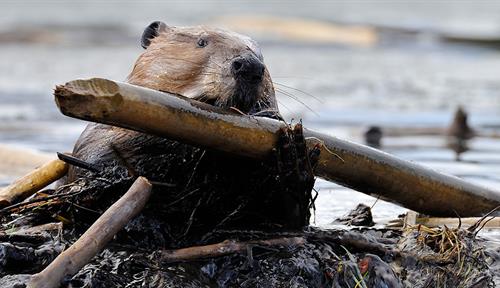A lifetime of love for the charismatic narwhal
An independent scientist working with the Inuit has unraveled many mysteries of the one-tusked ‘unicorn of the sea’
Support sound science and smart stories
Help us make scientific knowledge accessible to all
Donate today
Martin Nweeia is a modern Renaissance man. He has a degree in English and biology, a working dental practice, and a side interest in zoology and anthropology; he has composed for documentary films and has become an expert on narwhals — the mysterious, one-toothed “unicorns of the sea.”
The male narwhal typically hosts a roughly eight-foot-long, single exterior tusk, whose function has been a mystery for centuries. Nweeia has obtained many grants to investigate the narwhal and, in more than 20 trips to the Arctic, he has compiled ambitious logs of Indigenous knowledge about the tusk, conducted in-depth studies on the material it is composed of, and attached heart and brain monitors to narwhals to try to determine what they can sense through the protrusion.
Nweeia, whose dental surgery practice is based in Sharon, Connecticut, lectures at Harvard’s School of Dental Medicine and holds a global fellow position at the Polar Institute at the Wilson Center. He is also a research associate at the Arctic Studies Center of the Smithsonian Institution and at the Canadian Museum of Nature, and a member of the Zoonomia Consortium of Harvard/MIT.
Nweeia wrote about the narwhal in the 2024 Annual Review of Animal Biosciences. He spoke with Knowable Magazine about his work on teeth and narwhals and the insights he has gained from the Inuit who live with and hunt these whales.
This interview has been edited for length and clarity.
How did you come by your interest in narwhals?
It began with an interest in human teeth. I hadn’t started dental school yet, and I had an interest in anthropology. I went down to the Colombian Amazon, took molds of the Ticuna Indians’ teeth in part to help investigate migration patterns — where these people originally came from.
I kept up my interest in anthropology. In my first year of dental school, I disappeared off the clinic floor to go to Micronesia for a month. I got called into the clinic by the director, and he said, “You really need to make a decision: Are you going to become an anthropologist? Or a dentist?” I didn’t understand why I couldn’t do both.
I began to give talks around the country about dental anthropology, and I started including examples from animals. One of the animals that came up, obviously, was the narwhal.
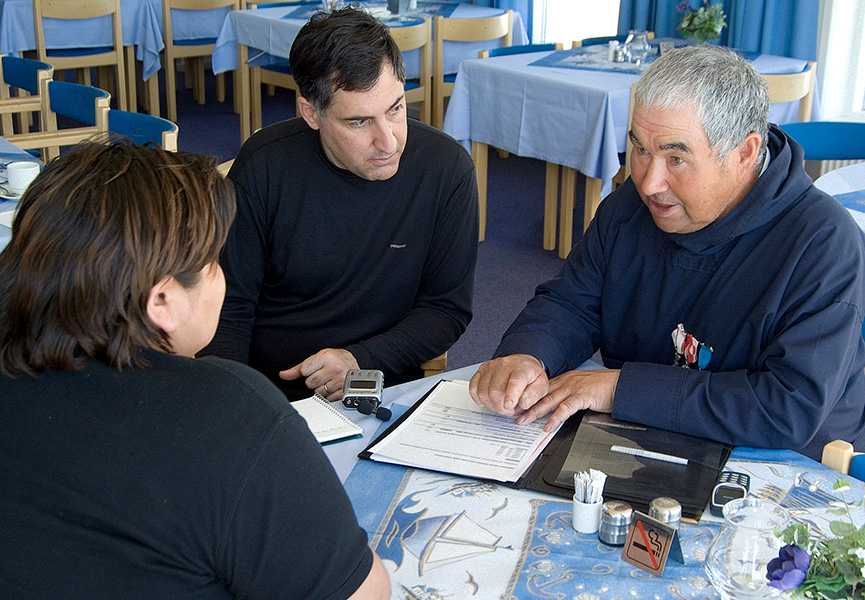
A Greenlandic elder and hunter (right) relays information about narwhal population numbers and changing migration routes.
CREDIT: JOSEPH MEEHAN FOR NARWHAL TUSK RESEARCH
What’s unique about this animal?
There are so many properties of the narwhal tusk that defy every principle I ever learned in dental school. The diet of the narwhal includes some pretty large fish. This whale has the capability of producing more than a dozen teeth in its mouth, but it genetically shuts this off — says “No, we don’t need those teeth. Instead, what we’d rather have is this giant tusk that erupts into the ocean.”
All mammalian teeth patterns are symmetrical. But a narwhal typically has this eight- to nine-foot tusk on the left, and on the right side, nothing visible. Typically, in mammals, females have the same distribution of teeth as males; narwhals couldn’t be more different. The males typically have the tusk and the females typically do not.
What did zoologists say this odd tusk was for?
The story was that this gigantic tusk was just for social hierarchy, like a lion’s mane or a peacock tail. The more I read, the less sense this made. Just to get the best girl of the lot? It doesn’t seem plausible to me. This animal has gone through an enormous sacrifice to create this thing. I thought, this animal deserves a better story.
Around the year 2000, I decided that I would devote myself to figuring this out. I continued to do dentistry, just turning to the narwhal every free moment. It substituted for the normal dentist’s golf game.
How did you start your investigations?
The first step was just getting up to the environment and seeing what I was going to face. I went up to the northern tip of Baffin Island to a town called Pond Inlet and was introduced to David Angnatsiak, the area’s best Inuit hunter and head of search and rescue, now deceased. Our first trip was pretty wild. We were on snowmobiles at three in the morning, in snowstorms, crossing ice floes.
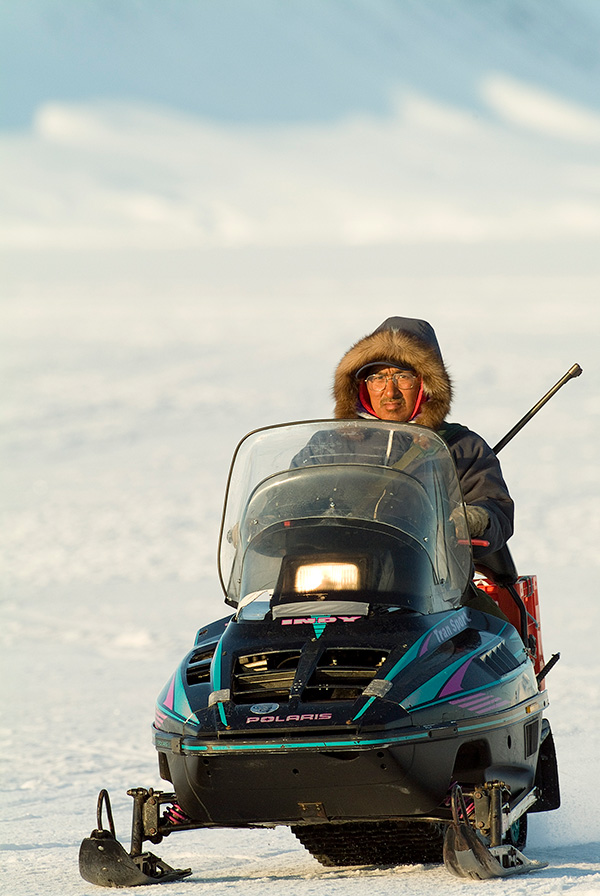
Hunter and search-and-rescue expert David Angnatsiak of Pond Inlet, Baffin Island, was Nweeia’s guide and friend.
CREDIT: JOSEPH MEEHAN FOR NARWHAL TUSK RESEARCH
There were two other film teams out there, with all kinds of equipment, constantly moving around. And David and I didn’t move for weeks. I said: Do those people know something we don’t know? David said: They can go wherever they want, the whales will be coming here. And sure enough, about maybe four or five days later, we saw thousands of whales. I thought to myself, it really matters who you go out on the ice with.
The first thing I remember is the sound, the breathing. It was so still, and I was just immersed in this soundscape. I didn’t want it to end. The tusk is very hard to see; they don’t always point it upwards. You have to be around them a lot to see the tusk.
How did you get tusks to study?
Because the Inuit are legally allowed to do subsistence hunting on these whales, I was able to get remnants from them and take samples back home.
The Inuit already had a much better description of the tusks than anything in Western science. They could tell from a tusk where a particular animal was from, which I found extraordinary: A shorter, thicker task would mean that they came from further north; longer and more thin tusks came from further south.
They knew the female tusk, when present, is thinner and more tightly wound. The tusk seems very rigid, but when we were in the field the hunters would say, oh, no, no, this thing bends and flexes. We thought, that’s impossible. So we get the material back in the lab and sure enough, it can bend and flex 12 degrees. I realized that they were going to be the most important key link for me to get the knowledge I needed to inform the science.
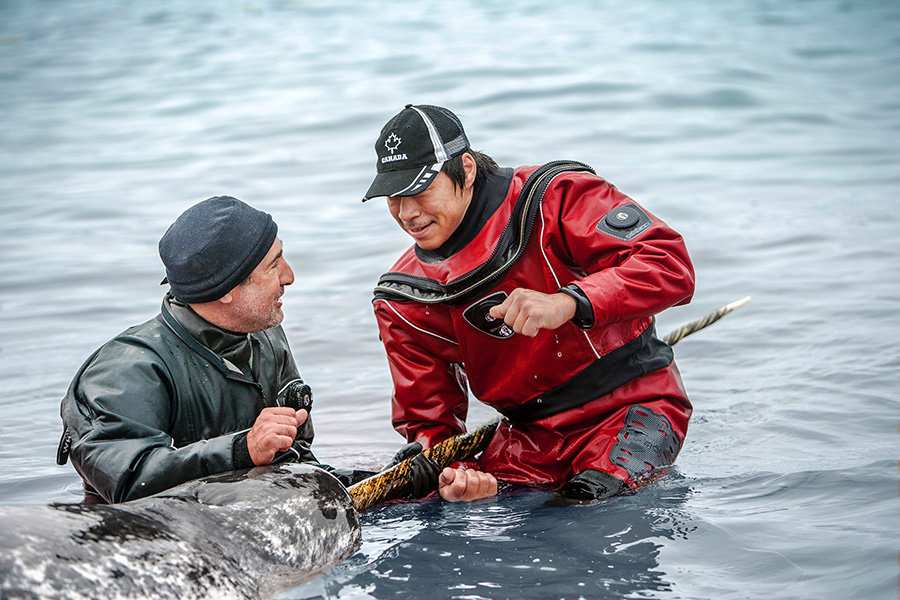
Martin Nweeia and Adrian Arnauyumayuk in the waters of Baffin Island, temporarily capturing a narwhal to enable study of the animal’s tusk.
CREDIT: GRETCHEN FREUND
What did you discover from your initial investigations?
I organized CT scans of the tusk, and electron microscopy, really focused on anatomy, working on the assumption that form leads to function. It is kind of opposite from our teeth, which are hard on the outside and softer as they go in; narwhal teeth are very flexible on the outside, and as you get to the core where the nerve is, it’s like an iron rod.
In 2005, we released work suggesting the tusk is a sensory organ. Our team found that over about an eight-foot section of tusk there were about 10 million sensory connections to its ocean environment, through dentinal tubules. All mammals have dentinal tubules — the difference with narwhal is that they’re open, from the inside nerve to the outside of the tooth.
In people, these tubules are below our gum line. People who have bone recession or receding gums can expose them, and this makes them sensitive to cold foods. So having the tubules open is unusual, especially for an animal living in the cold Arctic environment — it’s the last place you would expect to see this.
Current evolutionary evidence shows that teeth are derived from ancient fish scales, which had the capability to detect pressure, temperature and gradients of particles (like salt). We have slowly evolved to use our teeth for chewing and biting. But as we know from going to a dentist, our teeth can sense pain, and temperature. After all, they were, originally, sensory organs.
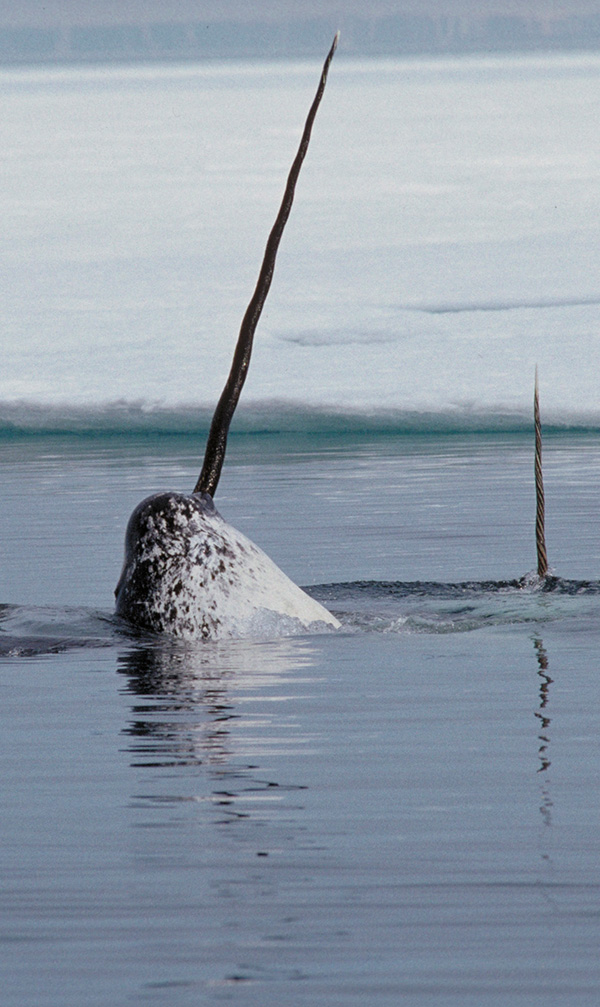
A narwhal raises its tusk. Scientists believe that this behavior helps the creature sense its environment.
CREDIT: GLENN WILLIAMS
Were you able to prove this sensory function?
By 2014, I was finally able to prove that this tusk in a living animal could sense its environment. I was working with Fisheries and Oceans Canada: We would capture a whale in a net and bring him to shore for a half an hour to be tagged. I would conduct my study during that time. I developed a plexiglass gasket that I could attach over a small section of tusk and fill with salty or fresh water. Then I would measure the whale’s brain and heart activity. The electrocardiogram was most accurate. I tested just six whales but had thousands of data points. And we showed that salty water led to a higher heart rate. Fresh water, a slower rate.
It took me a long time to work this out. People don’t understand how difficult it is to work in the Arctic: just to have the weather to be cooperative, let alone the whales to appear, and the techniques to do all this. To align all of these things in a way that you can actually get usable data is almost incomprehensibly difficult.
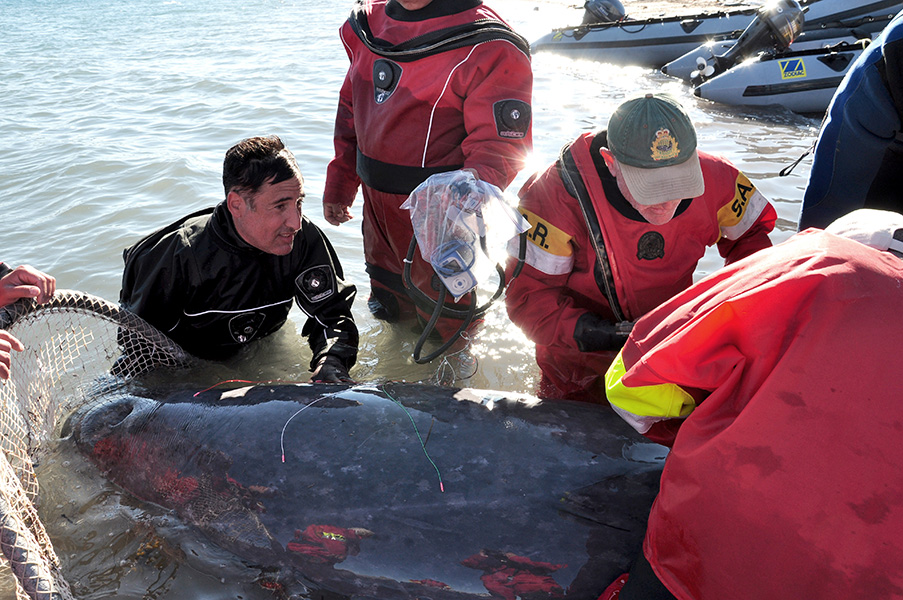
Martin Nweeia and a field team with Fisheries and Oceans Canada assess narwhal heart rate when the animal’s tusk is exposed to salty or fresh water.
CREDIT: CLINT WRIGHT
How is the narwhal population doing?
Narwhals are protected, but not endangered. There are roughly 170,000 narwhals, and it’s a sustainable population. The hunting quotas allow the Inuit to lead their subsistence lifestyles. The catch varies a lot; in Pond Inlet and Arctic Bay in their summer season, they might have a hunt of 150 whales. In 2015, government reports show that 766 narwhal were harvested in Canada and 408 in Greenland. The Inuit get a rich source of vitamin C from the skin since there are no orange tree equivalent sources in the Arctic. Because of the hunt they have a very deep connection, and a very deep sensitivity to understanding these animals.
What did you learn from the Inuit hunters about narwhals?
I went through six communities in Nunavut, Canada, and western Greenland, to collect interviews, over a two year period ending in 2010. One of the hunters, Rasmus Avike from Qaanaaq, had a striking statement explaining why the narwhal go into freshwater inlets every summer. They’re molting. He said: “I’ve only seen it once in my life. I just happened to be kayaking next to a narwhal and a very fine layer of skin came off. It almost looked like gauze in the water, and it dissipated within a minute.”
The literature will tell you that the diving time is no more than 20 minutes to 30 minutes. A hunter, trust me, knows the diving time, because they’re waiting for the whale to come up again. They put it at about 45 minutes.
Where have your studies led recently?
I was up twice last year. My studies now are more focused on genetics. We now have a reference genome for the narwhal. I also have a cell line at the frozen zoo in San Diego. The evolutionary path of the narwhal is interesting to me. Unlike an elephant, where we can see the whole delineation of how its tusks evolved over time, with narwhals there’s almost nothing. There is just the extinct Odobenocetops, which was found off the coast of Peru: It’s a whale that had two, asymmetric tusks, and interestingly, as noted in the recent article in the Annual Review of Animal Biosciences, they have similar dentinal tubules open to the surface. The other evolutionary link is a beluga relative, Bohaskaia.
I’m interested in “ocean osteoporosis.” As the ocean absorbs more carbon dioxide, it gets harder to form calcium carbonate. This affects shells. I’m looking at different trophic levels in the Arctic, to see how high up the levels this possibly can go. I’m also looking at nanoplastics, and their impacts on animals in the Arctic. To tell a story, you need a charismatic animal. You need a good storyteller. And I think narwhals are great storytellers.
Are there other animal tooth mysteries out there?
There’s the strap-toothed whale. He is my second favorite whale. These guys are found off New Zealand and Australia. They have two tusks that erupt from their lower jaw, wrap around their upper jaw and can restrict them from opening their mouths. Where did that come from? I mean, how counterintuitive can you possibly get?
But I want to devote all my time to the narwhal.
And, meanwhile, you’re still a practicing dentist?
I’m in my office now; you can come back and have your teeth done. It keeps a roof over my head, keeps myself fed. It funds the passion.
10.1146/knowable-060324-1
TAKE A DEEPER DIVE | Explore Related Scholarly Articles





